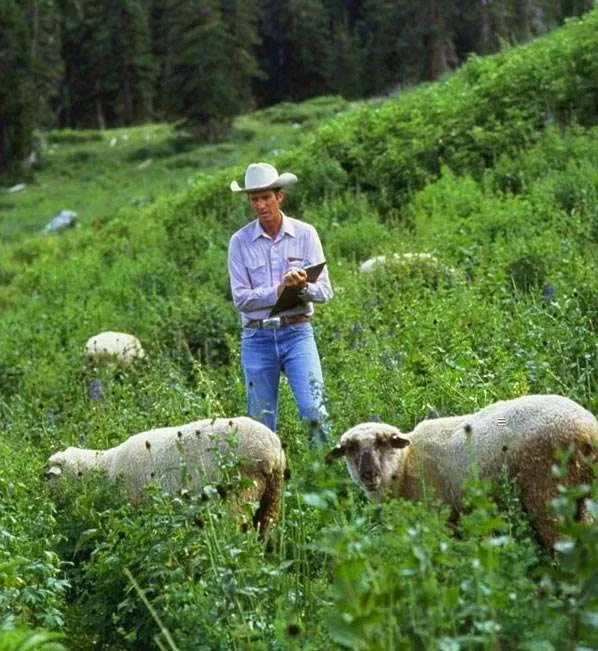Why Is It Important To Regularly Observe Healthy Animals?
- Observe - Larn how to recognize when animals look "off" due to an illness.
- Record - Prepare to go along records.
- Sample - Piece of work with your herd veterinarian to learn how to collect samples in the event they might exist used to test for disease during an outbreak.
- Report - Develop a communication programme so everyone knows how to report abnormal findings in your herd.
 The producer or animate being caretaker, in cooperation with the local veterinarian, is the first line of defense in protecting the herd from the spread of illness and diseases, start with the detection of a ill creature. Nearly farmers know their animals very well and can notice fifty-fifty subtle changes in an animal'due south behavior such as isolation, loss of ambition, sluggishness, etc., which can exist the first indications of an illness or injury. Animals exhibiting these small changes in behavior should be monitored closely and a veterinarian should be contacted if the signs do not disappear in a short menses of time.
The producer or animate being caretaker, in cooperation with the local veterinarian, is the first line of defense in protecting the herd from the spread of illness and diseases, start with the detection of a ill creature. Nearly farmers know their animals very well and can notice fifty-fifty subtle changes in an animal'due south behavior such as isolation, loss of ambition, sluggishness, etc., which can exist the first indications of an illness or injury. Animals exhibiting these small changes in behavior should be monitored closely and a veterinarian should be contacted if the signs do not disappear in a short menses of time.
More visible signs such as coughing, excessive salivation, diarrhea, abortions, and neurological disorders (e.g., circling, head pressing, stumbling, incomprehension) are obvious concerns. At the first sign of problems, a veterinarian should exist called to brand a farm visit for evaluation. If possible, the animals' caretakers should exist trained to determine heart rate, respiratory rate, temperature, and dehydration status. This data can exist useful during the commencement call to the veterinary to bespeak the severity of the problem. Knowing the number of animals afflicted also helps the veterinarian decide the extent of the trouble.
Proceed in heed that animals with infectious diseases exhibit signs of illness afterwards an incubation menses, which is the time from pathogen exposure to the time clinical symptoms announced. The incubation period can vary from hours to weeks, and with some diseases animals may be shedding the pathogen (and therefore exposing other animals to the biological agent) during that time.
An infectious disease is caused by pathogenic microorganisms, such as leaner, viruses, parasites or fungi. During a disease outbreak, it is of import to make up one's mind if the disease agent can be transmitted from one individual to some other.
There are generally two categories of transmissible diseases:
- Contagious - infectious diseases that tin spread from beast to animal are called contagious. A contagious disease is transmitted to other animals, either by physical contact with the animal suffering from the disease, by casual contact with their secretions or objects touched by them, or airborne routes. Contagiousness varies between diseases.
- Noncontagious - a illness that is non transmitted from animal to animal or contracted from objects.
Highly contagious diseases spread rapidly and may affect large numbers of animals; they tin can have a high morbidity and mortality rate and can be transmitted via direct and indirect routes. Infectious diseases classified equally non highly contagious generally spread slowly and affect a very small number of animals.
Look for Signs of Illness
WHEN

Generally, it is most effective to detect and assess an animal's health and well-existence as a single and split task, rather than combining it with other tasks or chores. If daily observations are combined with other tasks, the potential for missing something crucial increases, as the focus is on completing all of the tasks rather than observing the animal.
HOW
Detect each animal daily to assess its health and well-being. Carefully observe each animal from head to tail, including each function of its body and behavior, for abnormalities that may indicate a potential trouble. Also, look at the feces and belch from the animal if at that place is whatever, for signs of abnormalities. Establish a consistent method for conducting your daily observations. If you lot aren't certain how, consult with a veterinarian on how to perform daily observations of animals. Checklists and similar tools are helpful for ensuring daily observations are consistent and effective in assessing animal health and well-being.
WHAT
Things to consider when conducting your observations (not limited to the following):
Source: https://www.healthyagriculture.org/detect/animal-observation/
Posted by: motleychricand.blogspot.com

0 Response to "Why Is It Important To Regularly Observe Healthy Animals?"
Post a Comment